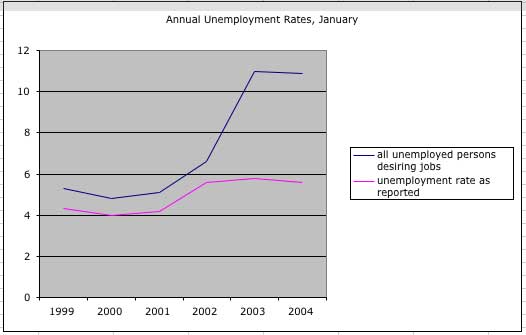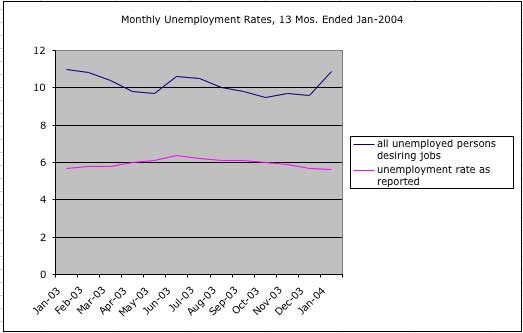Unemployment Statistics and What They Don't Tell You
As you may or may not know, the Bureau of Labor Statistics do not count certain unemployed persons in the splashy, front-page unemployment number. These people are described as follows: "In some month, about n persons were marginally attached to the labor force...These individuals wanted and were available to work and had looked for a job sometime in the prior 12 months. They were not counted as unemployed, however, because they did not actively search for work in the 4 weeks preceding the survey." So, these people want work, but didn't look during the month they did the household survey. Some economists and analysts refer to this as the "real" unemployment rate. For January, the reported rate is 5.6% and the "real" number is 10.9%
Historically, this number looks like this (these figures are for January of each year since that's all there is for 2004 and to make sure we are comparing seasonal apples to seasonal apples):

I wanted to go back to where we are firmly in the boom we all remember. As I recall, in early 2000, you could get a job at a NoVA telecom company if you could *spell* buzzwords like Java and Oracle. That ended in either January or March of 2000, depending whom you ask.
Here's last year's trend (13 months, January 2003 to January 2004):

I'm sure Wall Street is celebrating the improvement from December 2003, although the number came in lower than expected. I'm no expert, but these graphs certainly have a story to tell. The increase in real unemployment is a virtual spike, while the reported numbers show a less severe change. The really relevant thing here, I think, is that second graph. The trends are actually *opposite* one another, showing a worsening of the situation in recent months.
Regarding the job *creation* numbers (which, while released at the same time, are a different thing all togther), the Bush Administration would have us believe that the BLS has a known failure in that they don't measure small business and self-employment job creation accurately. If that's the case, why are so many people, an increasing number actually, still reporting that they can't find work?
all numbers courtesy of The BLS Employment Statistics Page
Posted by nicole at February 06, 2004 10:29 AM